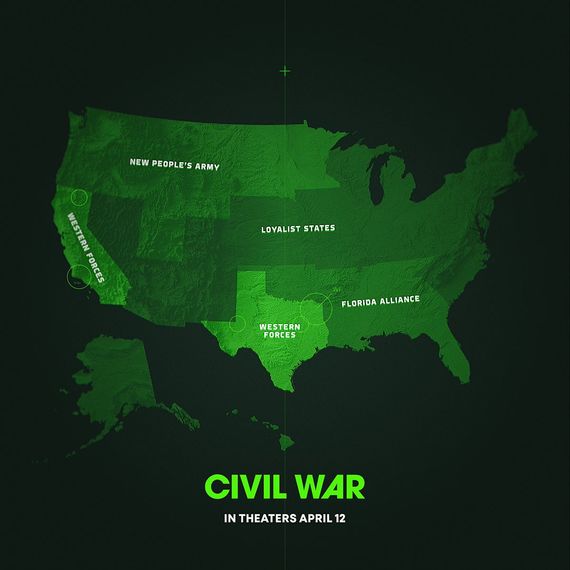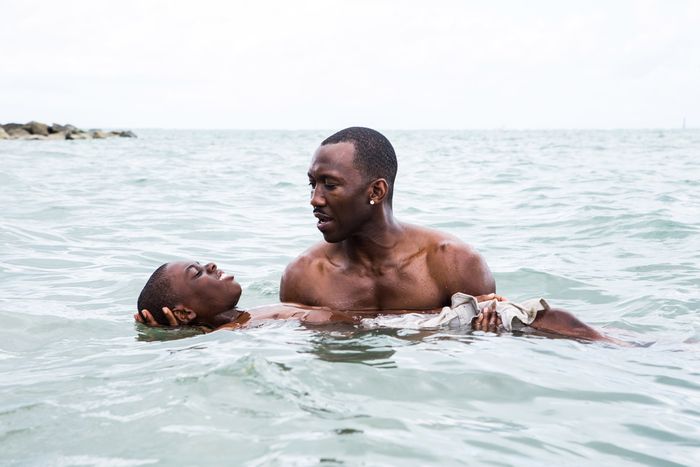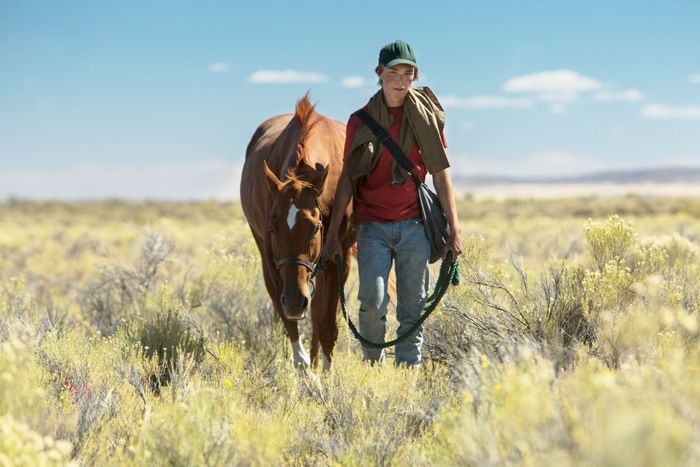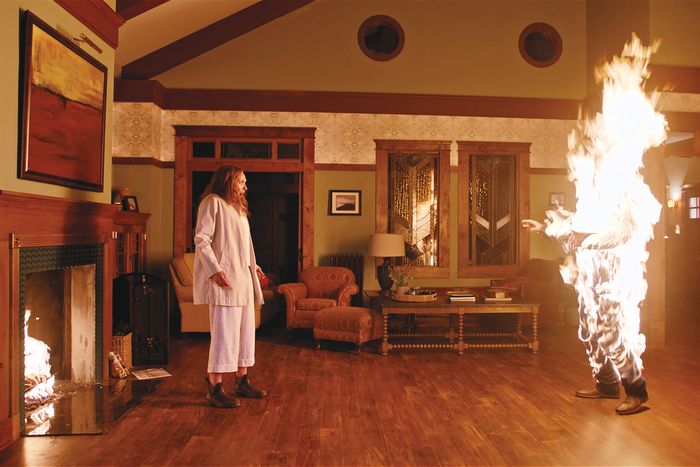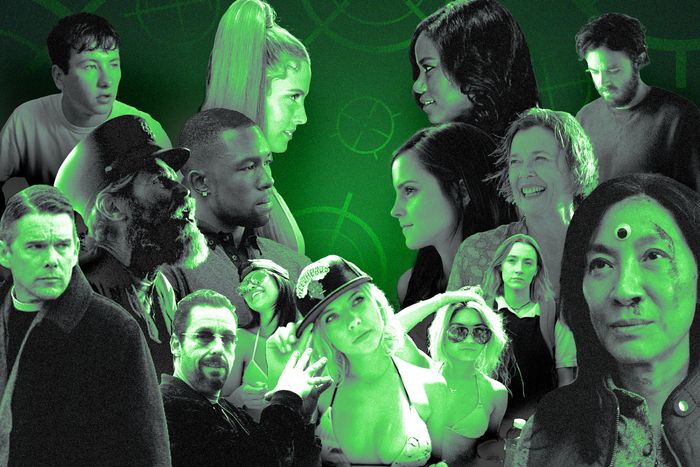
Ironically, no film this year has pitted critics against each other like Alex Garland’s Civil War. In one corner, writers who decry the film’s lack of specifics about the titular conflict. In the other, those who say that’s the whole point; the movie treats a hypothetical 21st-century civil war the same way Hollywood has long depicted conflicts in other countries: as contextless background noise.
Personally, I come down more toward the second camp, but I can’t fault anyone for wishing Garland had dived deeper into the alternate history of it all. Because while the actual film actively works against attempts to turn the underlying conflict into grist for the supplementary-content mill — Max Read calls it an “anti-explainer movie” — to sell Civil War to the public, A24’s marketing has leaned into the bird’s-eye-view, strategy-game approach. (I can’t fault the studio for this, either. Had it pitched Civil War as a film about the internal conflicts of war photographers, it would have grossed $3 million and been gone from theaters in a month.)
Take an image posted by A24’s social-media accounts earlier this month, asking fans to pledge their allegiance to one of the apparently four sides in the conflict. (The movie itself mentions only three.) This is a vision of the fictional civil war as a state-versus-state conflict with clear battle lines between the warring parties. The map was baffling at first glance, prompting a million wags to ask how conservative Texas and liberal California could possibly be on the same side, and it’s even more maddening after you see the movie, where the civil war is very much … not like this.
But it got me thinking: If A24’s Civil War is not exactly Alex Garland’s Civil War, then what would happen in an actual A24 civil war? If the characters from the studio’s 100-plus feature films had to fight a war based on the battle lines shown above, who would win? Could California — powered by iconic female characters like Saoirse Ronan’s Lady Bird and 20th Century Women’s Dorothea Fields — prevail? Would the neon-lit crazies of A24’s Florida movies be able to win their independence? Or would the massive manpower of all those New York City dramedies overpower all comers? That’s what we’re here today to find out. First, we’ll run down who’s on what side; then we’ll weigh up the combatants to see who’s going to come out on top.
(Note: We’re going by where films are set, not where they were shot. For instance, though Joel Coen’s The Tragedy of Macbeth was filmed on a Los Angeles soundstage, the story rather famously takes place in Scotland, which means Denzel’s usurper will not be taking part. Conversely, though Robert Eggers’s The Lighthouse was shot in Nova Scotia, its titular lighthouse is supposed to be off the coast of New England, so it counts.)
Western Forces
States: California and Texas.
Notable Films: The Bling Ring, 20th Century Women, A Ghost Story, Lady Bird, The Disaster Artist, mid90s, Gloria Bell, Under the Silver Lake, The Last Black Man in San Francisco, Red Rocket, Everything Everywhere All at Once, X, Pearl, The Iron Claw.
We need not concern ourselves with the question of whether the two most populous states would ever join forces against the sitting U.S. president. Instead, just admire the breadth of talent on display here. There’s brains in Annette Bening’s Santa Barbara boardinghouse matriarch from 20th Century Women, who’s got the leadership skills to corral a group that includes The Disaster Artist’s Tommy Wiseau and Simon Rex’s motormouthed porn star from Red Rocket. There’s brawn in the Iron Claw wrestlers and the verse-jumpers of Everything Everywhere All at Once. The Bling Ring kids and Andrew Garfield’s conspiracy-cracking stoner from Under the Silver Lake should adapt nicely to intelligence work. As every armed conflict in world history has proven, homicidal maniacs like Mia Goth’s Pearl often thrive in a wartime environment.
I’m not sure what tactical function Christine “Lady Bird” McPherson would serve, but you can bet she’d be glad that something exciting was finally happening to her.
Florida Alliance
States: Florida and the rest of the Southeast (except South Carolina), plus Oklahoma.
Notable Films: Spring Breakers, The Spectacular Now, Mississippi Grind, Moonlight, The Florida Project, Waves, Minari, Zola, Causeway, Priscilla, All Dirt Roads Taste of Salt.
Florida punches well above its weight in A24’s filmography. The Sunshine State provided the studio with its first hit, its first Best Picture winner, and a handful of other iconic titles. In a hypothetical war scenario, it may also be aided by the fact that a lot of its fictional characters happen to be absolutely insane. James Franco’s Alien in Spring Breakers (heck, the girls in Spring Breakers), Colman Domingo’s wildcard pimp in Zola, the kooky motel residents in The Florida Project — I’m not too sure about their ability to form a cohesive fighting force, but as an irregular defense, they are 100 percent going to fuck you up.
And they’d better, because there are also a lot of innocents here to protect: the queer teens of Moonlight, the lovelorn high-schoolers in The Spectacular Now and Waves, the adorable tots from Minari and The Florida Project, even poor Priscilla Presley. Just as he did in Moonlight, let’s hope Mahershala Ali’s Juan can keep an eye out. A lot is riding on Jennifer Lawrence’s injured veteran from Causeway and a film that basically doesn’t exist: Barely Lethal, a low-budget action comedy in which Hailee Steinfeld plays a teenage assassin.
New People’s Army
States: The Northwest and Mountain West, stretching south to Utah and east to Minnesota.
Notable Films: Laggies, The End of the Tour, Green Room, Lean on Pete, Hereditary, First Cow, Showing Up, The Whale.
One way you can tell that the Civil War map was likely produced by a random marketing employee and should not be taken as a serious statement of artistic purpose from Garland is that the “New People’s Army” is never actually mentioned in the film. In fact, the only time the Pacific Northwest ever comes up is in a stray comment about Maoists in Portland. (Likely place for them to be.)
Which is good, because most of the characters here are absolutely not getting involved in a war. These are among the least bellicose films A24 has ever released: dramas about sensitive oily-cake salesmen, frustrated ceramicists, lonely shut-ins, and boys who love horses. (David Foster Wallace is there on a book tour, too.) Unfortunately, you do have the white supremacists of Green Room, but if they can be defeated by one measly punk band, here’s hoping the Maoists take care of them.
Of course, none of the above applies to Hereditary, but let’s put a pin in that.
Loyalist States
States: A wide swathe of the country running from the Northeast to the Southwest.
Notable Films: Obvious Child, A Most Violent Year, While We’re Young, Slow West, Room, The Witch, It Comes at Night, Good Time, The Killing of a Sacred Deer, First Reformed, The Lighthouse, Uncut Gems, On the Rocks, Bodies Bodies Bodies, The Inspection, White Noise, You Hurt My Feelings, Past Lives, Problemista, Love Lies Bleeding.
Of all the sides in this conflict, the Loyalist States boast the largest population and the biggest geographical area, which is reflected in the fact that they also have the most movies. Unfortunately, a great many of these A24 films are dramedies about neurotic New Yorkers navigating relationship issues, the kind of characters you would least want on your side in a live-fire situation. Just imagine you’re in a foxhole. To your left, you’ve got Ben Stiller wondering whether he’s too old to hang with millennials; to your right is Greta Lee trying to choose between her childhood crush and her Xbox-loving husband. The person who’s supposed to have your back is Julia Louis-Dreyfus, but she’s mainly worried about whether her husband liked her book! In reserve are the woke zoomers of Bodies Bodies Bodies, who are almost certainly going to frag each other amid a heated debate about their respective levels of structural advantage. They’re not sending their best, is what I’m trying to say.
Luckily, it’s not all losers. I wouldn’t want to come up against Katy O’Brian’s female bodybuilder from Love Lies Bleeding in a fight, and while Robert Pattinson in Good Time and Adam Sandler in Uncut Gems don’t make the best strategic decisions, those Safdie protagonists certainly know how to seize the initiative, one of the U.S. military’s fundamental operational doctrines. And don’t discount the survivalist instincts of the postapocalyptic campers from It Comes at Night and Brie Larson in Room (which was set in Ohio, even though it’s the most Canadian movie ever made).
So Who’s Going to Win?
We can spend a lot of time debating whether Jenny Slate’s comedian from Obvious Child or the 13-year-old skateboarder from Mid90s is better suited to a mechanized infantry role, but ultimately, this debate is going to hinge on the fact that multiple A24 films include characters with superhuman abilities, whether those are comic-book-style powers or gifts bestowed upon them by some otherworldly force.
That’s bad news for the Florida Alliance. While A24’s Florida movies are often hyperstylized, all of them take place in a version of the real world where normal rules of physics apply. But for the other three sides of the conflict, figuring out who should win demands we embrace the perennial nerd debate about whose superpowers are most super. If you find this sort of thing tiresome, I suggest you leave now, because it’s about to get silly.
First up, hailing from Utah and representing the New People’s Army is Peter Graham from Hereditary, who by the end of the film is an empty vessel serving as host for Paimon, one of the eight kings of Hell. In the movie, Paimon mostly gets up to normal ghost stuff, but according to Occultist.net, he commands 200 legions of spirits. Pretty impressive!
However, you know what’s more impressive than being one of the eight kings of Hell? Being that guy’s boss. Unless you subscribe to the theory that the entire plot of The Witch is a hallucination suffered by the characters after eating contaminated wheat, the Devil himself is a character in Robert Eggers’s Massachusetts period piece, in both his guise as the goat Black Phillip as well as his human form. Now, as a supporting character, Satan is not automatically going to join the fight on the side of the Loyalist States. However, Anya Taylor-Joy’s Thomasin isn’t the only Devil worshipper in A24’s slate; there’s also the protagonist of the horror film The Blackcoat’s Daughter, who murders a bunch of people at an upstate New York boarding school to appease the dark lord. Given the presence of multiple Satanists in the Loyalist camp, I think it’s fair to expect Beelzebub to express some kind of rooting interest, especially with the eldritch terrors of The Lighthouse and Barry Keoghan’s hoodoo from Killing of a Sacred Deer also onboard.
Can the Western Forces come up with a fighter strong enough to overpower literal Satan? Indeed they can. Alone, I don’t know if California’s Evelyn Wang from Everything Everywhere All at Once possesses the power to go toe-to-toe with the Devil, no matter how many uses she can find for a butt plug. But she’s not fighting demons all on her own. The West also has Evelyn’s daughter Jobu Tupaki, whose verse-jumping has given her godlike abilities. Let’s run down the list of her powers: multi-versal consciousness, omniscience, reality manipulation, and transmutation — to say nothing about her capacity to create a black hole in the form of an everything bagel. I’ll admit to not being as up on Christian theology as I should be, but I think I would have remembered if the Devil had ever done anything like that in the Bible.
So there you have it. An actual A24 civil war would end with a laundromat owner from Simi Valley and her lesbian daughter punching the lights out of Satan and his malevolent spaghetti-eating sidekick. Isn’t that much more satisfying than whatever Alex Garland drew up?
More on Civil War
- Civil War Isn’t the Movie You Think It Is
- The Empty Perspective of Civil War’s Final Shot
- Jesse Plemons’s All-American Horror



